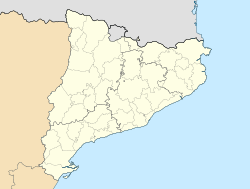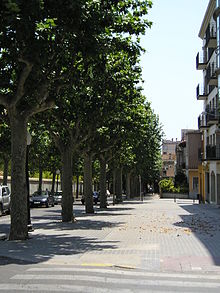- Mataró
-
Mataró — Municipality — Port of Mataró 
Flag
Coat of armsLocation in Catalonia Coordinates: 41°32′N 2°27′E / 41.533°N 2.45°ECoordinates: 41°32′N 2°27′E / 41.533°N 2.45°E Country  Spain
SpainCommunity  Catalonia
CataloniaProvince Barcelona Comarca Maresme Government - Mayor Joan Antoni Baron Espinar Area - Total 22.57 km2 (8.7 sq mi) Elevation 28 m (92 ft) Population (2010) - Total 122,932 - Density 5,446.7/km2 (14,106.9/sq mi) Demonym Mataroní Time zone CET (UTC+1) - Summer (DST) CEST (UTC+2) Website Official website Mataró (Catalan pronunciation: [mətəˈɾo]) is the capital and largest city of the comarca of the Maresme, in the province of Barcelona, Catalonia Autonomous Community, Spain. It is located on the Costa del Maresme, to the south of Costa Brava, between Cabrera de Mar and Sant Andreu de Llavaneres, to the north-east of Barcelona. As of 2010[update], it had a population of c. 122,932 inhabitants.
Contents
History
Mataró dates back to Roman times when it was a village known as "Iluro" or "Illuro". The ruins of a first century BC Roman bath house (known locally as the Torre Llauder) were recently discovered and can be visited. The coastal N-II highway follows the same path as the original Roman road.
Mataró was declared a city by royal decree, even though at the time (nineteenth century) the population fell short of the requirement for city status.
The first railway in peninsular Spain was the Mataró – Barcelona (opened on 28 October 1848), led by the Catalan businessman and Mataró native Miquel Biada. This line now forms part of the RENFE R1 suburban service between L'Hospitalet de Llobregat and Maçanet-Massanes. Mataró is also connected with Barcelona and Girona by the C-32 autopista (freeway) and with Granollers by the C-60 autopista.
During the 1992 Summer Olympics in Barcelona, Mataró was the starting point for the marathon events.[1]
Main sights
Mataró is the birth place of noucentista architect Josep Puig i Cadafalch, who designed the ajuntament (town hall) and several other notable buildings in the town:
- Casa Coll i Regàs
- Casa Parera
- Casa Sisternes
- El Rengle
- La Beneficiència
Nearby the town are the archaeological remains of the Roman villa of Can Llauder.
Agriculture
The traditional vineyards were devastated by Phylloxera in the nineteenth century and only partially replanted, due to the growth of the tourist industry and the development of irrigation in the area. Potatoes were one of the first replacement crops to be introduced, especially the Royal Kidney variety, and Mataró obtained a Denominació d'Origen in 1932.[2] Trocadero lettuce and peas are also grown, mostly for export. The production of cut flowers is less important than in other towns of the Maresme. Irrigated land made up 9.13 km² of the 10.57 km² of agricultural land in the municipality in 1986 (47% of the municipal territory).
Festivals, celebrations and events
Several major events are celebrated annually in Mataró. Some of them are also celebrated in the rest of Catalonia and others, which have a religious origin, are part of the folklore and traditions of Spain and some other countries. Among all of them the most popular ones are:
- The three wise men in Mataró.
- Carnival in Mataró: celebrated immediately before Lent.
- Easter in Mataró: celebrated every year during one week on a movable date from the end of March to the very beginning of May
- Saint George in Mataró: celebrated on the 23rd of April. It is a big celebration although it is not a bank holiday.
- Saint Joan in Mataró: celebrated on the 24th of June
- Les Santes: local festivity of the city celebrated at the end of July. It involves the recognition of Saint Juliana and Saint Semproniana.
- The Tió: celebrated in Catalonia on Christmas’ Eve, the 24th December.
- Mataró also celebrates several fairs such as:Tres Tombs and Saint Ponç In May it is celebrated a fair called Mercat de Sant Ponç. At the fair handicraft products, medicinal herbs, natural products like: honey,cheese, fruits, flowers, jam and salami are sold. Sant Ponç is the patron saint of the herbalists and bee keepers. The fair has been done for centuries. Its origins date to the 16th century, when in Spring herbalists took medicine to the sick. Today Sant Ponç fair is celebrated to preserve the antique customs.
- Festival "Cultural Crossroad"
- International Dance Festival "Days of Dance"
Twin towns
 Cehegín, Spain
Cehegín, Spain Dürnau, Germany
Dürnau, Germany Gammelshausen, Germany
Gammelshausen, Germany Créteil, France
Créteil, France Corsico, Italy
Corsico, Italy
References
- ^ 1992 Summer Olympics official report. Volume 2. pp. 204-6.
- ^ Source: Catalan Wikipedia. This Denominació d'Origen is not currently (2006) protected at European Union level (see list).
- Panareda Clopés, Josep Maria; Rios Calvet, Jaume; Rabella Vives, Josep Maria (1989). Guia de Catalunya, Barcelona:Caixa de Catalunya. ISBN 84-87135-01-3 (Spanish). ISBN 84-87135-02-1 (Catalan).
External links
- Official website
- Mataro Internet television
- City portal
- News of the city, Mataró, totmataro.cat
- Information from the Generalitat de Catalunya (Catalan)
- Information from the Institut d'Estadística de Catalunya (Catalan)
- Information from the Diputació de Barcelona (Catalan)
- Municipal museum (virtual visit)
- PB Mataró i totes les penyes d'arreu del món (Mataró collector)
- Mataro Wireless: free civic wireless network
Venues of the 1992 Summer Olympics Montjuïc Area Cross-country course · Estadi Olímpic de Monjuïc · Institut National d'Educació Física de Catalunya · Marathon course · Mataró · Palau de la Metal·lúrgia · Palau dels Esports de Barcelona · Palau Sant Jordi · Pavelló de l'Espanya Industrial · Piscina Municipal de Montjuïc · Piscines Bernat Picornell · Walking courseDiagonal Area Vall d'Hebron Area Parc de Mar Area Subsites A-17 highway · Lake of Banyoles · Camp Municipal de Beisbol de Viladecans · Canal Olímpic de Catalunya · Circuit de Catalunya · Club Hípic El Montanyà · Estadi de la Nova Creu Alta · Estadi Olímpic de Terrassa · Estadio Luís Casanova · La Romareda · L'Hospitalet de Llobregat Baseball Stadium · Mollet del Vallès Shooting Range · Palau d'Esports de Granollers · Parc Olímpic del Segre · Pavelló Club Joventut Badalona · Pavelló de l'Ateneu de Sant Sadurní · Pavelló del Club Patí Vic · Pavelló d'Esports de Reus · Pavelló Olímpic de Badalona · Sant Sadurní Cycling CircuitMunicipalities of Maresme Alella · Arenys de Mar · Arenys de Munt · Argentona · Cabrera de Mar · Cabrils · Caldes d'Estrac · Calella · Canet de Mar · Dosrius · Malgrat de Mar · El Masnou · Mataró · Montgat · Òrrius · Palafolls · Pineda de Mar · Premià de Dalt · Premià de Mar · Sant Andreu de Llavaneres · Sant Cebrià de Vallalta · Sant Iscle de Vallalta · Sant Pol de Mar · Sant Vicenç de Montalt · Santa Susanna · Teià · Tiana · Tordera · Vilassar de Dalt · Vilassar de Mar Categories:
Categories:- 1992 Summer Olympic venues
- Olympic athletics venues
- Maresme
- Municipalities in Barcelona
- Populated places in Barcelona
Wikimedia Foundation. 2010.





